Eldritch Perfect, Part 1
For every set, I go through the cards and tell some behind-the-scenes stories inspired by either individual cards or groups of cards. It's Eldritch Moon's turn for some card-by-card stories, so let's waste no time and get started.
Bruna, the Fading Light and Gisela, the Broken Blade
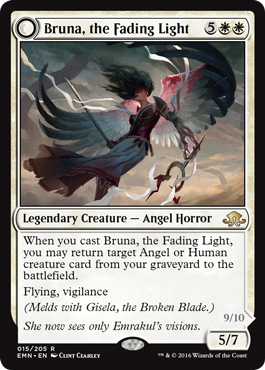
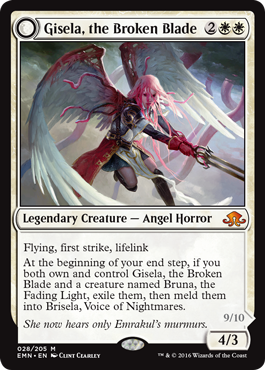
One of the things people ask all the time is this: at what point during the design do we know what the legendary characters are? The answer is that it can vary. Sometimes certain characters are known from exploratory world building and the design starts with a character already assigned to a card slot. Sometimes it happens during design and we get to try our hand at creating the card. Other times, the information can happen after design is done, and it's development that designs the card. So what happened with Bruna and Gisela?
That was the former. The two Angels melding together was illustrated during the initial world building with the artists. I'm not sure if the story people came up with the idea and inspired the artists to draw it or if the artists drew it and inspired the story people to make a story about it, but either way, Eldritch Moon design started with us knowing full well that we were showing the melded Angels.
I think the earliest thoughts were of us making a single double-faced card with Bruna and Gisela on the front fighting side by side and on the back merging together. As I explained in my first preview article, it was trying to solve this design that got Ken Nagle to come up with the idea of melding cards.
Once we knew we were doing the meld design, we had to actually figure out how to properly design each of the Angels. We knew that we wanted Bruna and Gisela to each have different abilities (well, other than flying—all Angels fly), which we would then combine on the melded card. What are white's creature keywords? Well, it gets double strike, first strike, flying, lifelink, and vigilance as a primary or secondary ability. Double strike was a bit much, and they both needed flying. That meant we got to divvy up first strike, lifelink, and vigilance.
That's three abilities. We wanted each of the Angels to have the same number of abilities, so that meant we needed one more thing. An "enters the battlefield" trigger worked well because we didn't have to move that over to Brisela, as the melded card wouldn't enter the battlefield. Also, we wanted to have the power and toughness line up so that Brisela had the combined power and combined toughness of the two Angels. (Interestingly, with various tweaking of the cards, we accidentally had them not add up, and this was caught late in the process and fixed.)
We came up with reanimating an Angel or Human as the enters-the-battlefields trigger. It's a little bit of a color pie bend, as white traditionally reanimates small creatures, but the flavor was so good we left it alone (and Humans, at least, tend to be small). We decided that Bruna would get to be bigger and have the enters-the-battlefield trigger. That meant that she would only get one of the three keyword abilities. We chose vigilance for her, as it worked better with her stats.
Gisela was made a bit smaller and given first strike and lifelink. It was important to keep her text short, because one of the two Angels had to have the transform text that caused them to meld together if they were both on the battlefield. Brisela then got all four keywords shared between the two and had a combined power and combined toughness. Then, for some extra oomph, we gave her one more ability. Originally it was protection from instants to make her extra hard to kill (remember that protection is deciduous, meaning we can print it from time to time), but we ended up wanting to put that somewhere else (more on that below), so we changed her ability to something that proactively stops small spells.
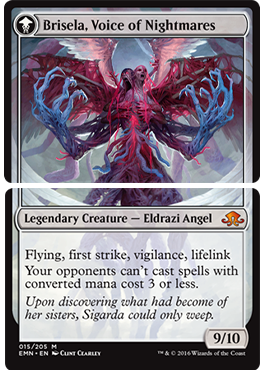
This is the kind of design that requires a lot of fiddling to get right, but I'm very happy with where the cards ended up.
Dark Salvation
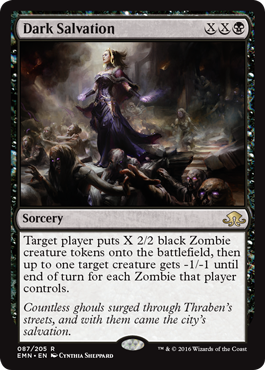
Liliana's here and she's necromancing up a storm. Dark Salvation was designed as a card showing Liliana kicking butt with her Zombies. The trick was that we wanted the spell to be both creature destruction and token-making. How could we connect the two? The key was finding a way to tie each Zombie made into the creature destruction. I believe an early version of this card experimented with each Zombie getting to give -1/-1 to target creature until end of turn, but that ended up being too powerful, and the spell would often decimate the other side when cast late in the game. The solution was to disconnect the targeting from the Zombie tokens. Instead of each token generating an effect, the spell now generates the -N/-N effect, which allowed us to limit it to targeting a single creature. Yes, getting more Zombies is better because the effect is larger, but because you can only hit one creature, the effect is topped out as basically a creature destruction spell, so you can get a lot of Zombies but you only ever get to kill one creature.
Emrakul, the Promised End
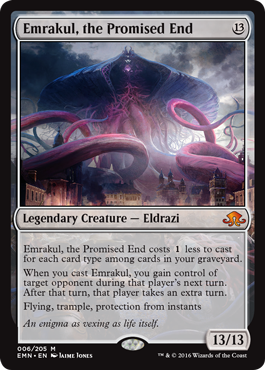
A lot of people have been curious how exactly Emrakul ended up in Innistrad. I don't mean story-wise, as obviously the creative team did a great job of explaining how that happened. I mean, when did we decide that we wanted Emrakul on Innistrad? The answer takes us back a number of years. R&D did an offsite where any person who was interested could take 5 minutes and talk about whatever topic they wanted. Adam Lee worked on the creative team at the time (he has since moved over to work on Dungeons & Dragons), and he wanted to use his 5 minutes to talk about a neat idea for a new take on Innistrad.
Adam's idea wasn't focused on story but rather on how to make a cool world. What if we could take our Gothic horror world and push it in a new direction? What if we embraced a different kind of horror? Adam's idea was to embrace cosmic horror. What if some outside force was causing all of the denizens of Innistrad to go mad and slowly started mutating them? He knew it would work best if the outside force was a known quantity, and the most obvious candidate was Emrakul. Adam's presentation was well received and everyone agreed that someday we should do that.
Fast-forward a year or two. We'd decided to go back to Zendikar, and there was going to be a war between the Eldrazi and the Zendikari. We had three sets to play with and three titans, so the theme of how to flavor each set seemed clear. We'd start with an Ulamog set, then have a Kozilek set, and then end with a set with the biggest, baddest titan of them all, Emrakul. And then, mid-design, we changed from a three-block model to a two-block model.
Now, I had already begun building an Ulamog-themed set. What were we supposed to do? We couldn't just have two titans. The Eldrazi were iconically three. If we did only two, the audience would keep asking where the third one was. Maybe that wasn't a bug, though, but a feature. What if Emrakul was gone because she was lured somewhere else? What if her absence played into the next block? We were already looking for ways to make the story more continuous and connected. Let's take our lemons and make lemonade.
With all the hype, we knew that we had to make sure to deliver with the new Emrakul. The goal was to make Emrakul big and splashy but also tied mechanically to the block. The first thing we stumbled upon was the fact that we had somehow never made a creature with a converted mana cost of 13. The Momir Basic online format was very focused on creature converted mana costs, so the absence was often raised. But thirteen is a very big number, so we wanted to find a way built into the card to help you get it out cheaper.
Hmm, the block already had the delirium mechanic, forcing players to count card types in their graveyard. What if we used that as a cost-reduction method? Also, if we were embracing thirteens, why not make Emrakul a 13/13? True, last time she was a 15/15, but it was close enough. Original Emrakul had flying, so it seemed important to keep that. Original Emrakul also had annihilator and protection from colored spells. We weren't bringing back annihilator, so we swapped it for trample. Protection from colored spells got changed to protection from instants.
As both of those were a slight step down, we decided to up the cast trigger (all Eldrazi titans have an effect when cast). Original Emrakul gave you an extra turn. What if we tweaked that by giving you an extra turn—just not an extra turn for you? Emrakul was driving the denizens of the world mad, why not also your opponent? We ended up using the Mindslaver "gain control of target opponent" ability. To keep it from being too overpowered, we gave your opponent an extra turn the turn after you took them over. This way you essentially get an extra turn, you're just using it to hurt your opponent rather than help yourself.
And that is how we made a second Emrakul.
Falkenrath Reaver
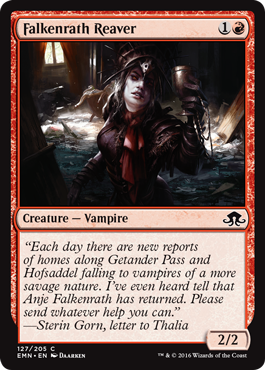
If I asked you which Eldritch Moon card caused the most discussions in R&D, would you have picked Falkenrath Reaver? In fact, the discussions around this card long predate Eldritch Moon. Limited Edition (Alpha) had the card Grizzly Bears, a 2/2 vanilla for two mana, one of which was generic and one green. R&D later decided that white could have a 2/2 vanilla for 1W. And for years, green and white were the only colors that could do that. Yes, other colors had two-drop 2/2 creatures, but they always came with a drawback of some kind.
Then in Innistrad we made a 2/2 vanilla for 1B. That led to huge amounts of debate. Is that something black was able to get? In the end, we decided yes. Well, eventually the conversation turned to the next color in line—red. Red's limitations in cheap vanillas had been causing problems. Many argued that red should also be allowed a 2/2 vanilla for 1R. This debate has been going on for a while, but it finally got settled in Eldritch Moon. The answer we reached was yes, it can. As we've made creatures better over the years, we've upped the creature curve, and finally red gets a Grizzly Bears.
This, of course, creates a new question, one I'm sure R&D will debate for years to come—how about blue?
Galvanic Bombardment and Take Inventory
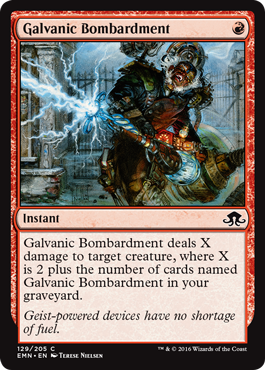
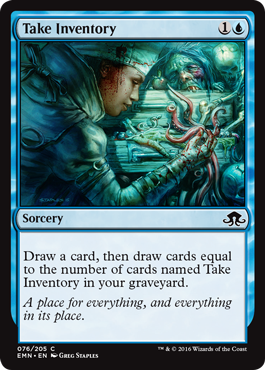
The very first set I led the design for was Tempest. In it, I made the following card:
In design, the card was called "Plague Bolt," as its design was trying to take what Plague Rats did and apply it to a direct-damage spell. Each copy made the other copies stronger. The trick I figured out to do this was to count how many you'd already cast (okay, technically cards in your graveyard, but most likely they got there by you casting them—counting cards in the graveyard was easier than remembering how many you had previously cast) and incrementally increase the damage for each card. Then two years later, we made a blue version of Kindle called Accumulated Knowledge:
I would revisit this yet again in Odyssey with a cycle of cards called the Bursts. Anyway, I'm a fan of Kindle technology, so when it became clear that Shadows over Innistrad was looking for ways to mess with the graveyard in a different way than original Innistrad, I suggested we try using the Kindle mechanic. We tried it. There was enough other stuff going on that it didn't end up being the right fit, so we left it out.
In Eldritch Moon design, though, we decided that we could do a little, so we went back to the very beginning and decided to tweak the two cards that first put the Kindle mechanic on the map, Kindle and Accumulated Knowledge. Galvanic Bombardment and Take Inventory are close but with a few small tweaks.
First off, both Kindle and Accumulated Knowledge counted cards in all graveyards. Back in the day, that's just how we did effects that looked for things, much like tribal cards didn't just affect all your creatures but all creatures of the chosen type. Over the years, we've realized that the gameplay was better (and easier to parse) if your things mostly just affected or counted your other things. That means the first change is that both cards only look at copies of the card in your graveyard.
Each card had basically one other change. Galvanic Bombardment differs from Kindle in that it can only hit creatures and cannot hit players, but the mana drops from 1R to R because of this shift. Take Inventory is identical in rules text (other than the change of the name of the card) but shifts from an instant to a sorcery. The reason for this is a power-level one, as Accumulated Knowledge is powerful enough to be played in Eternal formats.
Gisa and Geralf
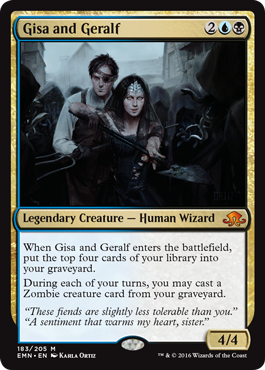
Innistrad block delivered most of the things that the audience wanted but not everything (more on this when I get to Ulrich of the Krallenhorde next week). One of the things we missed was creating cards for Gisa and Geralf, the Zombie-making sister and brother. Gisa is a necromancer and Geralf is a stitcher (the difference between Liliana and Dr. Frankenstein). The audience was introduced to Gisa and Geralf in Innistrad's flavor text and quickly took a liking to them. The problem is that flavor text gets done late enough in the process that it's too late to make cards for characters that end up shining (that weren't known ahead of time).
We eventually printed Gisa and Geralf as legendary creature cards in a Commander product. And all was good. Of course, when we returned to Innistrad, it was obvious that we'd need to make another version of each of them. We didn't end up finding room for them in Shadows over Innistrad. There were other legendary characters that had more of a role in the story. We put the siblings into Eldritch Moon but eventually got ourselves in a bind because there was so much else going on—we didn't have space for both of them.
We talked about which one to remove. Would the audience be happier to see Gisa return or see Geralf return? In the end, we realized we had the wrong answer. Why choose one? We ended up putting them together on the same card. The card made Zombies; both Gisa and Geralf made Zombies. It fit flavorfully, and it was kind of cool to see them together on a card. It also made it different from last we saw them. And that's how the sister and brother ended up on the same card.
Imprisoned in the Moon
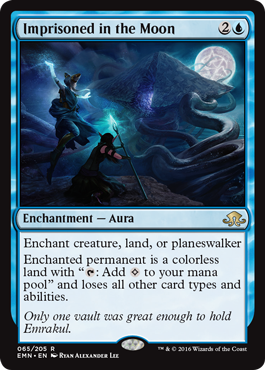
Each set, we have what we call the "pivotal moments" cards. That is, cards that show key moments of the story. The final part of the Eldritch Moon story has Tamiyo imprisoning Emrakul in Innistrad's moon (the Helvault was a piece of the moon, so it has good prison capabilities). Tamiyo is primarily a blue mage (more on that when I get to Tamiyo's card), and this card was showing her using her magic to imprison Emrakul, so it really needed to be on a blue card. But this effect, mechanically, isn't particularly blue.
We talked about an Aura that locked things down, but that seemed a little too mundane. This was a giant event. We needed something a little bigger and splashier. Okay, how exactly can you mechanically convey imprisoning something in a moon? Blue doesn't destroy things, and imprisonment really isn't destruction. We could exile a creature, but it's not really in blue's slice of the pie. Blue could steal a creature or bounce a creature, but those didn't feel right.
Blue can transform creatures. Was there some way to use transformation? What if you shut off a creature by making it do something different? That led to the question, what conveys being part of a moon? We experimented with a bunch of different ideas but ended up with transforming the creature into a mana generator. What if the creature lost all its abilities and could only tap for a colorless mana? It was a big color pie bend but not quite a break. We ended up allowing you to enchant not just a creature but a land or planeswalker to give the card a little more flexibility.
And that is how we ended up with one of the oddest cards in the set.
Sudden Death
That's all the time I have for today. I hope you're enjoying my peek into the design of Eldritch Moon. As always, I'm eager to hear your feedback on both today's column and Eldritch Moon. You can send me an email or talk to me through any of my social media accounts (Twitter, Tumblr, Google+, and Instagram).
Join me next week for part two, when I finally get to tell a story I've been waiting for many years to tell.
Until then, may you create some Eldritch Moon stories of your own.
"Drive to Work #346—History of Limited"
Inspired by an article by Brian David-Marshall, I did a podcast looking back at the early days of Limited and how it evolved.
"Drive to Work #347—Stand-up Comedy"
Based on a request from my blog, this podcast talks about the things I learned from my days of doing stand-up comedy and how those lessons affect how I design Magic.
- Episode 347 Stand-up Comedy (19.3 MB)
- Episode 346 History of Limited (17.5 MB)
- Episode 345 Twenty Lessons: Resonance (15.4 MB)
- Episode 344 Urza's Saga, Part 4 (24.9 MB)
- Episode 343 Urza's Saga, Part 3 (16.7 MB)

